Academy’s 1/72 Bf 109E & Kettenkrad | 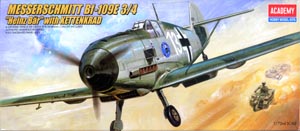 | History The Bf 109 is probably the best-known World War Two fighter, and much has been written on it over the years. Rather than rehash what others have written, I’ll just say that this kit is of the Bf 109E-3/4 variant, which featured larger wing guns than the earlier E-1 variant, resulting in underwing bulges. Another change found on many E-3/4 planes was the canopy, which changed from a curved piece to a square-edged piece. The Bf 109E saw service in Spain, Poland, France and the Battle of Britain before being replaced slowly by later Bf 109 variants. The Kit 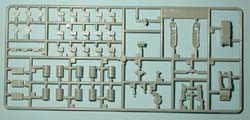 This is a reissue of two Academy kits, the Bf 109E and the Kettenkrad. Both are molded in a light gray plastic, with a sprue of clear for the windscreen and canopy. The tooling on both kits is crisp and feature recessed panel lines. The Kettenkrad sprue comes with extra parts such as barrels, gas cans, and crates (although the instructions mark them as unused parts). Options for the Bf 109 include two styles of canopies and a bomb with rack for the belly. This is a reissue of two Academy kits, the Bf 109E and the Kettenkrad. Both are molded in a light gray plastic, with a sprue of clear for the windscreen and canopy. The tooling on both kits is crisp and feature recessed panel lines. The Kettenkrad sprue comes with extra parts such as barrels, gas cans, and crates (although the instructions mark them as unused parts). Options for the Bf 109 include two styles of canopies and a bomb with rack for the belly.
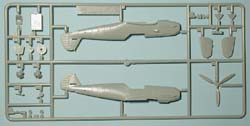 The Kettenrad kit is pretty basic, consisting of only fourteen parts. The main hull is molded as one piece, with the tracks and wheels molded separately as right and left pieces. This will make painting a bit tricky, as the tracks are not separate, but a fine brush and a bit of time should do the trick. The rest of the assembly is straightforward and should go together quickly. Painting is simple as well, being overall panzer gray or desert yellow. A small decal is included for the rear license plate. The Kettenrad kit is pretty basic, consisting of only fourteen parts. The main hull is molded as one piece, with the tracks and wheels molded separately as right and left pieces. This will make painting a bit tricky, as the tracks are not separate, but a fine brush and a bit of time should do the trick. The rest of the assembly is straightforward and should go together quickly. Painting is simple as well, being overall panzer gray or desert yellow. A small decal is included for the rear license plate.
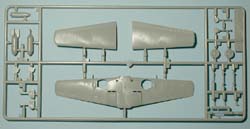 Looking at the Bf 109 kit, the construction is also straightforward with no hidden construction problems. The interior is basic but reasonably detailed, with a separate floorboard, rear bulkhead and seat making up the majority. Sidewall detail is molded into the fuselage halves, and a separate trim wheel is provided for the port side. A control stick, rudder pedals and instrument panel finish off the interior. Looking at the Bf 109 kit, the construction is also straightforward with no hidden construction problems. The interior is basic but reasonably detailed, with a separate floorboard, rear bulkhead and seat making up the majority. Sidewall detail is molded into the fuselage halves, and a separate trim wheel is provided for the port side. A control stick, rudder pedals and instrument panel finish off the interior.
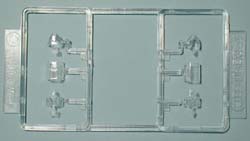 The fuselage is split into right and left halves, and the propeller/spinner assembly is designed to be sandwiched between the two. The wings come in three pieces, with a one-piece lower wing ensuring the proper dihedral. Tailplanes are molded as right and left pieces, with separate struts fitting into recessed holes in the fuselage and tailplane. The landing gear is simple as well, consisting of just a strut, a wheel, and a wheel door for each side. The tailwheel is molded as one piece. Finally, control horns for the ailerons and an underwing pitot tube are provided as separate pieces. The fuselage is split into right and left halves, and the propeller/spinner assembly is designed to be sandwiched between the two. The wings come in three pieces, with a one-piece lower wing ensuring the proper dihedral. Tailplanes are molded as right and left pieces, with separate struts fitting into recessed holes in the fuselage and tailplane. The landing gear is simple as well, consisting of just a strut, a wheel, and a wheel door for each side. The tailwheel is molded as one piece. Finally, control horns for the ailerons and an underwing pitot tube are provided as separate pieces.
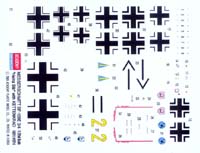 The decal choices in this kit are good ones, covering the aircraft of two pilots, Heinz Bär and Helmut Wick. What is really nice about this decal sheet is that it provides two choices for both pilots. Heinz Bär’s first aircraft is a Bf 109E-3 from the summer of 1939. This plane is finished in RLM 70/71 over 65, with a low demarcation along the fuselage. What makes this plane interesting is the large underwing crosses, covering the full span of the wing. The second plane of Heinz Bär is from September 1940 in France and is camouflaged in RLM 71/02 over 65 with a high fuselage demarcation. Both planes are numbered White 13. The decal choices in this kit are good ones, covering the aircraft of two pilots, Heinz Bär and Helmut Wick. What is really nice about this decal sheet is that it provides two choices for both pilots. Heinz Bär’s first aircraft is a Bf 109E-3 from the summer of 1939. This plane is finished in RLM 70/71 over 65, with a low demarcation along the fuselage. What makes this plane interesting is the large underwing crosses, covering the full span of the wing. The second plane of Heinz Bär is from September 1940 in France and is camouflaged in RLM 71/02 over 65 with a high fuselage demarcation. Both planes are numbered White 13.
Helmut Wick’s plane is a Bf 109E-4 and the two options in this kit are from the autumn of 1940. Both options are of the same plane at different times, so the camouflage is the same. This consists of RLM 71/02 over 65, with a mid-fuselage demarcation. The fuselage is covered with RLM 70 or 71 stippling, resulting in an interesting look. The first option is Yellow 2 and features a handful of white kill markings on the rudder, Wick’s personal emblem on the cowling, and the JG 2 unit emblem under the windscreen. The second option is from a couple months after the first, so there’s more kill markings on the rudder. The rudder and cowling are painted yellow, and the yellow 2 has been replaced with a chevron arrow. The decals are very well printed and provide all the various crosses needed by all four aircraft. A set of stenciling is also included. The only thing missing from the sheet is the swastikas, which will need to be supplied from somewhere else. Conclusion This is a nice little kit of the Bf 109, made even better with the addition of the Kettenkrad. While the Tamiya kit is a bit better all around, this kit is very buildable and will result in a good-looking model of a Messerschmitt. | 








|
